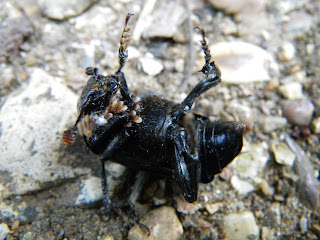"Wet, wet, wet" may seem like a strange title bearing in mind the glorious sunshine we have had today, but if you had been here, you would understand why.
'Fraid I haven't got a clue what has been about bird wise other than the fact that the warblers are all still warbling away and I did see a brambling when I dropped into the Woodland Hide in passing, but Michelle opened and is currently locking up and we both spent the day with 20 odd 8-12 year olds (as in more than 20, but if you saw them, you may have thought they were a little strange!) exploring the aquatic environment.
What I can tell you is that there are plenty of smooth newts in the pond and lots of dragonfly nymphs, including some very large hawker type individuals who will be emerging in a few weeks time. the highlight for most of the children was a voracious
great diving beetle larva and the
leeches of which there were several.

After lunch, and an impromptu woodland exploration we headed down to the river to test the abilities of the junk model wetland adapted beasties that the group had made and then had great fun racing through what, apart from the children, was a perfectly idyllic setting! The river always looks fantastic in the spring and this year is no exception, with the first of the bluebells now just starting to flower.

After testing the models we split into two camps - those that just wanted to mess about in the water and do the kinds of things that kids used to do in rivers before over the top health and safety got in the way, and those that wanted to river dip. The dippers caught a wide variety of invertebrates, highlights being minnow, bullhead (including a particularly large specimen that very happily devoured every freshwater shrimp the blood-thirsty children caught for it) and beautiful demoiselle nymphs.
At the end of the session the children were very wet and very happy, which, coupled with the sunshine sums up a perfect "Playday". More of the same tomorrow with the 5-7 year olds, so if you were planning on visiting the reserve tomorrow, you have been warned!

 As it was Thursday, the volunteers were in, fifteen people, including one new recruit worked near the Goosander hide and clearing some old fencing on the shore of Mockbeggar Lake. On the way we passed along "Peony Bank", so called because there is a magnificent red flowered specimen that grows beside the path there. How it got there is unknown, the bank is the former edge of a silt pond and a haul route, not an obvious location for such a plant.
As it was Thursday, the volunteers were in, fifteen people, including one new recruit worked near the Goosander hide and clearing some old fencing on the shore of Mockbeggar Lake. On the way we passed along "Peony Bank", so called because there is a magnificent red flowered specimen that grows beside the path there. How it got there is unknown, the bank is the former edge of a silt pond and a haul route, not an obvious location for such a plant. At lunchtime I went to the Tern hide and was rewarded with a good range of birds. At least 15 common tern may have included some migrants, the 3 black tern were certainly passing through. A common sandpiper and a greenshank were putting on a good show in front of the hide, I got a reasonable picture of the greenshank, always tricky as they don't stand still.
At lunchtime I went to the Tern hide and was rewarded with a good range of birds. At least 15 common tern may have included some migrants, the 3 black tern were certainly passing through. A common sandpiper and a greenshank were putting on a good show in front of the hide, I got a reasonable picture of the greenshank, always tricky as they don't stand still. In the afternoon I was briefly in the alder carr south of the Centre and found a caterpillar under a lichen covered log. I suspected it might be a footman of some sort, so took a picture and having checked it turned out to be a dingy footman. The larvae of this moth eat lichen, not an obvious caterpillar food, but actually not unusual, quiet a few species do not eat the green leaves we generally assume they do.
In the afternoon I was briefly in the alder carr south of the Centre and found a caterpillar under a lichen covered log. I suspected it might be a footman of some sort, so took a picture and having checked it turned out to be a dingy footman. The larvae of this moth eat lichen, not an obvious caterpillar food, but actually not unusual, quiet a few species do not eat the green leaves we generally assume they do.




















 Newts were again much in evidence in the catch, though unusually palmate newt featured more than the smooth newts that are caught more frequently, examples pictured here (palmate followed by smooth newt):
Newts were again much in evidence in the catch, though unusually palmate newt featured more than the smooth newts that are caught more frequently, examples pictured here (palmate followed by smooth newt):









 Bob heard his first cuckoo of the year yesterday up by
Bob heard his first cuckoo of the year yesterday up by 















